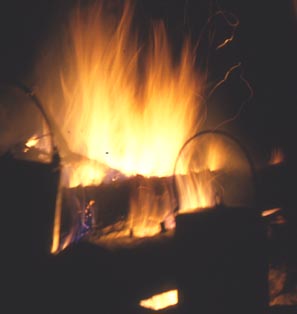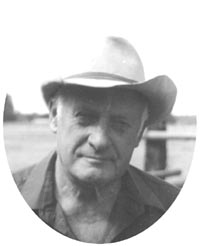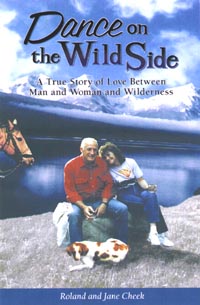WHERE -
CULTURE
TALES ARE TOLD OF
a weblog sharing info on outdoor skills and campfire musing by a guy who spends a bunch of time in pursuit of both
Roland is a gifted writer with a knack for clarifying reality. Looking forward to more of his wisdom
- Carl Hanner e-mail
Welcome to Roland Cheek's Weblog
Why is a conservative conservationist like me doing a blog? I've gone four years without writing a newspaper column and six years since I signed off on my last radio program. That's more than enough for a thoughtful guy given to decades of hands-on observation of God's wonders to remain mute in the face of multitudes of peccadilloes. You have my pledge to remain meditative, clear, cogent, and refreshing. Along the way, I hope to offer the occasional tip to help make your next outdoors adventure the kind of pleasureable experience you're seeking.
To access Roland's weblog and column archives
Click Here
Tip o' the Day
When looking for wildlife, there are key fundamentals one should bear in mind:
1. Location
There's no profit in searching for antelope in a forest, or mountain goats in a swamp. But that same swamp offers survival food for bears emerging from hibernation in the spring. In summer and late fall, however, those same bears can be found feeding on mountainside berries.
2. Patience
Wild creatures are usually alert to movement. If you don't believe it, try sneaking up on a rockslide used by pikas, the little alpine rock rabbits. It'll be a barren landscape. Be patient, though. Sit down (I've even gone to sleep). Without movement, the creatures will soon be running all over the rocks.
3. Good optics
There's no substitute for good optics. I do my initial scanning with binoculars, then set up a spotting scope to zero in. I also employ my secret tool -- a wife who's a wonder at spotting animals.
You'll note I listed those fundamentals in their order of importance. One can have the patience of Job and it will do him no good if he's in the wrong location. Similarly, one can carry the best optics made, but without patience and location, his efforts and expense will come to naught.
There's another point to be made here: of the above fundamentals, only one can be obtained with money. Those most important can only be accessed with the coin of our own efforts.
In case I've not made it clear, I have little regard for those who expect to buy their way to outdoors expertise by relying on ever more sophisticated -- and expensive --gadgetry.
It ain't gonna happen.
I am the fourth generation of a Montana ranch family and am very close to the land, and greatly concerned about what happens to it. Your columns take me that much closer to the land and certainly echo my sentiments.
* Jim Milos / Great Falls, MT
Books by Roland Cheek from Skyline Publishing
Recent Weblogs
Tuesday, September 23, 2008
Comments
BACKUP VIEWMASTER
Few people fail to thrill to the sight of a silver-struck grizzly sauntering through a wildflower-filled meadow; or of a red-cockaded woodpecker in waltz-flight through a pine forest; or of a whitetail buck scratching the top of his rump with the long tines of a set of magnificent antlers. Unfortunately, participation in these kinds of visual adventures are usually limited--not so much for opportunity, but for lack of time.
Or lack of patience.
Viewing wild animals is not always, as some suppose, a matter of being in the right place at the right time. Most of the time successful wildlife watching is an art. As such, three elements must coalesce in order for viewers to draw the prize.
The first required element is solitude, which, of an by itself is a means justifying its end without even throwing in the possible glory of sighting a couple of six-pont pull elk squaring off in a mountain meadow at twilight. Perhaps absolute solitude is not always absolutely necessary, but successful wildlife watching cannot often be accomplished in a crowd.
Second is patience. It's a fact that wild animals punch no time clocks. Neither do they care squat about your nightly need to watch the stock market report or transport Johnny to Little League. If they, on a whim, decide to visit the next county, they do so without asking a by-your-leave. They sleep when they wish, eat when hungry, grow passionate during season, and turn cautious in the presence of their most fearsome adversary--man. So it's you who must exercise patience, sometimes inconveniencing yourself and others in order to catch a glmpse of a gigantic grizzly digging for marmots in a boulder patch.
The third requirement is skill. Skill comes only with practice. Michelangelo did not pop from the womb a polished artist, and neither will you excel in finding and viewing wild creatures without both careful study and constant practice. And that's not to say one must spend that time only in the middle of Glacier National Park. Jane and I have watched goldfinches and hummingbirds at her feeders, cottontails cavorting on our lawn, cock pheasants crowing at pasture gates, and pine squirrels leaping from one windbreak tree to another. There've been flights of mallards and pintails, snow geese and honkers winging north in the spring and south in the fall. Redtails and sparrow hawks soar circles over our pasture, and whitetails steal apples from our trees.
Fortunately becoming a wildlife viewmaster does not demand that one be lithe as a swimmer, stout as a weightlifter, or agile as a gymnast. Neither must you be shapely as a model, dextrous as a typist, or handsome as an actor. Instead, viewmastering is an acquired skill available to everyone. When I married the girl-next-door, I was the outdoorsman, the hunter; she was a town girl with no discernible accomplishments in outdoor skills.
Fifty years later I can pilot our family sedan down a macadam highwat at fifty miles per hour while the lady scans a hillside. Often she'll spot the outline of an elk standing in a copse of trees. She's uncanny.
The reason Jane is presently so much further advanced in spotting wildlife than her husband is because she brings near-total focus to the activity. With her it's absolute concentration. Me? I can be sitting in the passenger seat and begin thinking about a time my packstring slid down an avalanche slope similar to the one on the mountain I'm gazing at. I look, but I don't see. Jane not only sees, but she records the animal and cries, Stop! Stop! There's a five-point bull elk with a twisted brow tine standing in the lodgepole thicket!.
It helps that she has previously spotted an unusual break in tree symmetry and the outline proved to be an animal. It helps that she has earlier spotted deer grazing a medow edge at dusk or bears digging skunk cabbage in a marsh in the spring. It helps, too, that her ears are sharp and finely attuned to every sound--the slight scratches of a squirrel scampering up the bark of a tree, the far off honking of not-yet-in-sight Canadas winging their way south.
But it helps most of all that her eyes are constantly searching and her concentration absolute. No ridgetop mule deer dares flick his tail while she's in the valley below, no bear lift an ear, no grouse cock an eye, no squirrel cut cones from a fir tree.
Pretty cagy of me isn't it? Unable to become the viewmaster I'd like myself to be, I developed my very own, private, in-house back up. I'm proud of me.
And her
Roland Cheek wrote a syndicated outdoors column (Wild Trais and Tall Tales) for 21 years. The column was carried in 17 daily and weekly newspapers in two states. In addition, he scripted and broadcast a daily radio show (Trails To Outdoor Adventure) that aired on 75 stations from the Atlantic seaboard to the Pacific Ocean. He's also written upwards of 200 magazine articles and 12 fiction and nonfiction books. For more on Roland, visit:



Cheek combines his vast outdoor experiences as an outfitter in Montana with solid research to provide a thoroughly readable and enjoyable book. It reminded me of two other books, John McPhee's Coming Into the Country about Alaska, and Sebastian Junger's Perfect Storm
* Franklin Marchman in an amazon.com review
I picked up your book My Best Work Is Done at the Office and I was reading it until 2:00 in the morning. I haven't touched my other books since.
* H. Robert Krear / Estes Park, CO
For more info about these and other Roland Cheek titles
I just finished your book Dance On the Wild Side. I didn't want it to end. Where did you learn to write like that?
* Barb Richards e-mail
Dance On the Wild Side is terrific reading, part true life adventure, part inspiration, and part blueprint for a life worth living.
* The Midwest Book Review
A self-made naturalist, Cheek has a thing about grizzly bears that some people feel defies understanding. Readers can thrill to a mesmerizing tale of grizzly bears and humans who, in chilling detail, morph into a lethal mix
* Outdoors Unlimited
I just finished reading The Phantom Ghost of Harriet Lou and it touched my soul. You've illustrated everything I embrace about hunting and elk hunting to be more specific
* Mitch Ratigan email
Montana's Bob Marshall Wilderness
9 X 12 Coffeetable size 97 full-color photos
For interested educators, this weblog could be appropriate for use in journalism and writing classrooms, and might be of secondary use for reading instruction and social studies curriculums.
Roland, of course, visits schools. For more information on his school programs, go to:
Then there's the Western Adventure series: six novels chronicling the adventures of a young mixed blood fleeing from the results of his exacting vengeance on his parents murderer. Start with Echoes of Vengeance.
for detailed info about each of Roland's books
Read reviews
Read each title's first chapter
NEXT WEEK:
ANOMOLOUS ADVENTURE
www.campfireculture.com
to send this weblog to a friend
to tell Roland what you think of his Campfire Culture weblog
to visit Roland's newspaper columns and weblog archives
source links for additional info
There's a bunch of specific info about Roland's books, columns, and archives. By clicking on the button to the right one can see Roland's synopsis of each book, read reviews, and even access the first chapter of each of his titles. With Roland's books, there's no reason to by a "pig in a poke"








